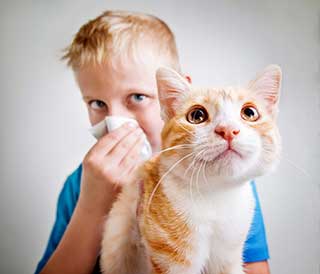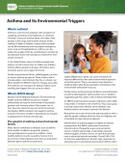Introduction
Millions of Americans live with pets despite being allergic to them. Any furry animal, most commonly cats and dogs, may trigger allergy symptoms like sneezing or red, itchy eyes. Pet allergies can also make asthma harder to control.
You may think animal allergies are caused by fur, but that fuzz and fluff is merely a carrier for allergens.1 Pet dander, the source of allergens, is composed of tiny, even microscopic, proteins from flecks of skin shed by pets.
- Cat allergens are found in cat saliva, which sticks to fur when cats lick themselves. They are also released by glands in the skin and shed as dander or secreted in the urine of male cats. The allergens are buoyant, which means they easily remain airborne.
- Dog allergens are also present in dander, as well as saliva, urine, and blood. Although allergen levels can differ among breeds,2 all breeds, even hairless dogs, can trigger allergies.
Pet allergens are easily spread. They can circulate in air and remain on carpets and furniture for months. These small particles may also be carried on clothing into areas where there are no pets.
Preventive Strategies
If you suspect you or a loved one is allergic to a pet, you can get tested.
There are many options for reducing exposure to pet-related allergens, and the following (2MB) may help:
- Keep pets out of the bedroom where an allergic person sleeps
- Encase mattresses and pillows in special allergen-proof fabric covers
- Remove or replace carpets
- Vacuum regularly, but when the person with allergies is not present, using a cleaner with a HEPA filter (high-efficiency particulate air, which is a type of mechanical air filter) or a double-layered micro filter bag
- Use a portable air cleaner with a HEPA filter for the allergic person's bedroom
- Avoid certain ionic air cleaners that can generate harmful ozone
- Keep pets off furniture and out of cars
- Bathe dogs, which may decrease allergens if done at least twice a week for effectiveness
- After playing with your pet, wash your hands and clothes to remove pet allergens
- Avoid contact with soiled litter
- Dust often with a damp cloth
-
Shah R and Grammer LC, 2012. Chapter 1: An overview of allergens. Allergy Asthma Proc 33 Suppl 1: S2-5. [Abstract Shah R and Grammer LC, 2012. Chapter 1: An overview of allergens. Allergy Asthma Proc 33 Suppl 1: S2-5.]
-
Vredegoor DW, Willemse T, Chapman MD, Heederik DJ, Krop EJ., 2012. Can f 1 levels in hair and homes of different dog breeds: lack of evidence to describe any dog breed as hypoallergenic. J Allergy Clin Immunol 130(4):904-9. [Abstract Vredegoor DW, Willemse T, Chapman MD, Heederik DJ, Krop EJ., 2012. Can f 1 levels in hair and homes of different dog breeds: lack of evidence to describe any dog breed as hypoallergenic. J Allergy Clin Immunol 130(4):904-9.]
What is NIEHS Doing?
Pet allergens in homes – Scientists at NIEHS found that more than 50% of households have a dog, cat, or both.3 Nationwide studies showed dog and cat allergens were present in almost all U.S. homes, even those without pets.4

Endotoxins and pets – NIEHS scientists determined that people who have more contact with house-dust endotoxins, particles created when bacteria die and disintegrate, may wheeze more. These people are more likely to be younger, have lower family income and Hispanic ethnicity, live with dogs, cats, or smokers, and have cockroaches and carpeted floors in the home.7 Another NIEHS study showed that pet allergens along with endotoxins in a home could make wheezing and asthma worse.8
Age and allergens – The effects of allergens on children may depend on age. NIEHS-funded researchers found that inner-city children who had more contact with specific allergens and bacteria before age 1 were less likely to have wheezing and allergy symptoms when they were older.9 This finding suggests such early-life exposure may help build a defense in the body against developing wheezing and allergic diseases.
-
Gergen PJ, Mitchell HE, Calatroni A, Sever ML, Cohn RD, Salo PM, Thorne PS, Zeldin DC, 2018. Sensitization and exposure to pets: The effect on asthma morbidity in the US population. J Allergy and Clin Immunol. In practice 6(1):101-107.e2. [Abstract Gergen PJ, Mitchell HE, Calatroni A, Sever ML, Cohn RD, Salo PM, Thorne PS, Zeldin DC, 2018. Sensitization and exposure to pets: The effect on asthma morbidity in the US population. J Allergy and Clin Immunol. In practice 6(1):101-107.e2.]
-
Arbes SJ Jr, Cohn RD, Yin M, Muilenberg ML, Friedman W, Zeldin DC, 2004. Dog Allergen (Can f 1) and Cat Allergen (Fel d 1) in US Homes: Results from the National Survey of Lead and Allergens in Housing. J Allergy Clin Immunol 114(1):111-7. [Abstract Arbes SJ Jr, Cohn RD, Yin M, Muilenberg ML, Friedman W, Zeldin DC, 2004. Dog Allergen (Can f 1) and Cat Allergen (Fel d 1) in US Homes: Results from the National Survey of Lead and Allergens in Housing. J Allergy Clin Immunol 114(1):111-7.]
-
Thorne PS, Mendy A, Metwali N, Salo P, Co C, Jaramillo R, Rose KM, Zeldin DC, 2015. Endotoxin Exposure: Predictors and Prevalence of Associated Asthma Outcomes in the United States. Am J Respir Crit Care Med 192(11):1287-97. [Abstract Thorne PS, Mendy A, Metwali N, Salo P, Co C, Jaramillo R, Rose KM, Zeldin DC, 2015. Endotoxin Exposure: Predictors and Prevalence of Associated Asthma Outcomes in the United States. Am J Respir Crit Care Med 192(11):1287-97.]
-
Mendy A, Wilkerson J, Salo PM, Cohn RD, Zeldin DC, Thorne PS, 2018. Exposure and sensitization to pets modify endotoxin association with asthma and wheeze. J Allergy Clin Immunol Pract S2213-2198(18):30280-0. [Abstract Mendy A, Wilkerson J, Salo PM, Cohn RD, Zeldin DC, Thorne PS, 2018. Exposure and sensitization to pets modify endotoxin association with asthma and wheeze. J Allergy Clin Immunol Pract S2213-2198(18):30280-0.]
-
Lynch SV, Wood RA, Boushey H, Bacharier LB, Bloomberg GR, Kattan M, O'Connor GT, Sandel MT, Calatroni A, Matsui E, Johnson CC, Lynn H, Visness CM, Jaffee KF, Gergen PJ, Gold DR, Wright RJ, Fujimura K, Rauch M, Busse WW, Gern JE, 2014. Effects of early-life exposure to allergens and bacteria on recurrent wheeze and atopy in urban children. J Allergy Clin Immunol 134(3):593-601.e12. [Abstract Lynch SV, Wood RA, Boushey H, Bacharier LB, Bloomberg GR, Kattan M, O'Connor GT, Sandel MT, Calatroni A, Matsui E, Johnson CC, Lynn H, Visness CM, Jaffee KF, Gergen PJ, Gold DR, Wright RJ, Fujimura K, Rauch M, Busse WW, Gern JE, 2014. Effects of early-life exposure to allergens and bacteria on recurrent wheeze and atopy in urban children. J Allergy Clin Immunol 134(3):593-601.e12.]
Further Reading
Additional Resources
Fact Sheets
Asthma and Its Environmental Triggers
- Common Asthma Triggers - CDC's Asthma website provides information on how to avoid common asthma triggers.
- Immunoglobins: Testing for Allergies - An immunoglobulin (IgA, IgE, IgG, IgM) test measures the level of certain immunoglobulins, or antibodies, in the blood.
- Pet Allergy: Are You Allergic to Dogs or Cats? - Allergies to pets with fur are common, especially among people who have other allergies or asthma.
- What Is Pet Dander? - Pet dander is composed of tiny, even microscopic, flecks of skin shed by cats, dogs, rodents, birds and other animals with fur and feathers.
Related Health Topics
This content is available to use on your website.
Please visit NIEHS Syndication to get started.



